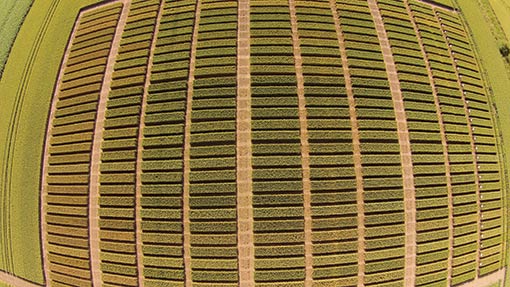Best practice agronomy benefits biodiversity

Sustainability is a long-term business, as BASF is proving at its network of demonstration farms across Europe.
But alongside the company’s objective of showing how valuable resources can be protected and biodiversity increased, the day-to-day activities of commercial farming have to continue – with crop yields and profits being given the same level of attention as bird and insect numbers.
See also: 9,000 farmers sign up for farmland bird count
In the UK, this is taking place at Top House Farm in Rawcliffe Bridge, Humberside, where BASF has been working with the Hinchliffe family since 1996.
Further afield, there are now 11 farms in six European countries in the Sustainability Farms network, all of which provide the industry with practical learning and discussion opportunities.
“They are all privately owned and commercially farmed,” points out Graham Hartwell of BASF.
“And that’s important. These farms are facing the same challenges as others in their areas.”
Key findings
For UK farmers, one of the key findings to come from 12 years of biodiversity monitoring at Top House Farm is that it is possible to provide resilient biodiversity by taking just 2-3% of land out of production.
“It can be done,” stresses Mr Hartwell. “If the measures introduced are established properly and well managed, there’s an opportunity to increase biodiversity across the whole farm quickly and successfully, without having to sacrifice any further productive area.”
That finding fits in well with BASF’s sustainability strategy and shows how profitable modern farming can go hand in hand with environmental responsibility, he believes. “It’s all about the optimal use of resources – in this case land – and the very best management of that resource.”
Getting the message across
He acknowledges that timescales have to be balanced and a long-term view is often required, something that can be challenging to convey to the many audiences that visit the farm, including politicians and pressure groups.
“A good example of this is the long cold winter of 2012-13 and subsequent wet summers. Our bird numbers reduced in 2013 as a result, but in the years that we’ve been monitoring them here they’ve increased enormously on this farm.”
Mr Hartwell believes that the work that has been done to date has given enough information on how to establish and manage quality biodiversity measures – things that farmers can introduce to make a rapid and lasting difference.
“The next step is to look at the effect we can have on crop yields from some of these. Field margins, for example, can harbour high enough numbers of insects and wildlife to have a beneficial effect on the neighbouring crop area.
“So as well as their a biodiversity value, they may also increase farm profitability. That’s where the sustainability story becomes two-way.”
High fungicide spend proves right approach for 2014
A comparison of nine different spray programmes across 30 winter wheat varieties is showing that, not surprisingly, a high spend on fungicides has been the right approach this year, says agronomy manager Tom Scanlon.
Very high disease pressure across the Rawcliffe Bridge site has seen many wheat varieties struggle to maintain green leaf area, with both septoria and yellow rust being able to take a hold where crops were left without sufficient protection.
“Brown rust is coming in now as well,” he reports. “So it’s been a year when we’ve been able to see some marked differences between programmes and treatments, adding to our knowledge about how varieties respond and fungicides perform.”
A “belt and braces” four-spray programme costing £150/ha and containing new generations SDHIs at T1 and T2 has performed well, he notes. “At that price, you would expect it to. The chemistry is standing up well to everything the season is throwing at it.”
The value of the T0 spray has also become apparent, he acknowledges. “After such a mild winter, there was plenty of disease inoculum around. The T0 spray is no longer optional; we should see a 0.25t/ha yield boost from it.”
Chlorothalonil is also showing its worth, adds Mr Scanlon. “In a protectant year, it has added to the disease control achieved. And that’s not just at T0, it has played a useful role at the T1 and T2 timings too, without adding much to the costs.”
The BASF product, Tracker, in a mix with chlorothalonil, has worked well at T1 again, where it is an established choice, he reveals. “It is SDHI chemistry, which can be forgotten.”
The gap between T1 and T2 has been important on virtually all varieties, showing the importance of timeliness, he adds.
Looking ahead, Mr Scanlon suggests that varieties will have a more prominent role to play in managing the disease risk on farm. “There’s no doubt that the resistance ratings are of more interest than they were.”
A trial looking at the responses of the two top yielding feed wheat varieties, KWS Kielder and Evolution, reveals that both show good responses to inputs.
“On paper, Evolution has the better disease resistance of the two. But they are capable of producing the same yield with the right agronomy through the season.”
Where differences are apparent between them is with the use of a two-spray programme based on triazoles, he reports. “Evolution is looking cleaner. The value of its disease resistance is showing.”
A very detailed agronomy trial with three different seed, fungicide and PGR rates, as well as two nitrogen rates, is being conducted this year.
“The final yields will tell us most of the story, but we’re already seeing differences in green leaf area.”
In summary, use of higher seed rates and nitrogen has produced more ears/sq m and more green crop. But there’s also more disease, with higher rates of fungicide being required.
“The extra nitrogen does seem to create its own set of problems. But there’s also some evidence that high fungicide and nitrogen rates can work in synergy, to give more green leaf area and ultimately more yield.”

